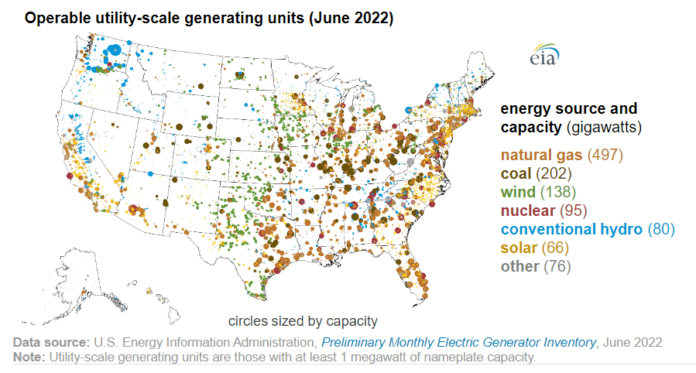
The U.S. Energy Information Administration’s (EIA) latest inventory of electric generators shows 15 GW of new utility-scale electric generating capacity came online in the United States during the first half of 2022. Based on the most recent plans, developers could add 29 more GW to their capacity in the second year.
EIA’s Preliminary Monthly Electric Generator Inventory compiles information on all U.S. utility-scale power plants (plants with a nameplate capacity of at least 1 MW) that are currently operating, planning to come online, or retired. This inventory includes all utility-scale power plants that have been retired since 2002.
The largest share of the 15.1 GW capacity that was online in the United States in the first half 2022 is made up of wind generation, which accounts for 34%. Natural gas, solar, and battery storage are close behind. Texas accounts for more than 40%, or 2.2 GW, of the total wind capacity of 5.2 GW. The Traverse Wind Project in Oklahoma is the largest renewable project to go online within the first six month of 2022. There are also the 492MW Maverick Creek Wind in Texas and the 440MW solar and battery storage projects at Slate Hybrid, California.
According to developers and project planners, the United States will add 29.4GW of new capacity during the second half of 2022. Nearly half of the capacity is planned to be from solar (13.6GW), followed closely by wind (6GW). Many projects are expected to go online in December as tax incentives allow.
Respondents to EIA’s survey currently plan to add 3.7 GW less solar capacity in 2022 than what they had expected at the beginning of the year. This could be due to supply chain problems related to pandemics or a U.S. Department of Commerce tariff investigation.
Over half (8.5 GW) of the 15.1 GW of electric generating capacities that U.S. operator plan to retire in 2022 were retired in the first six months of the year. Natural gas (12%), nuclear (9%) and coal-fired power stations will all account for 76% each of the retirements this fiscal year. The 1,305 MW William H. Zimmer power plant in Ohio, which ceased operations in May, and the 1,205MW Morgantown Generating Station (Maryland), which ceased operations in June, are the two largest U.S.-based coal power plant retirements. In June, the 769-MW Palisades nuclear power plant in Michigan also retired.
